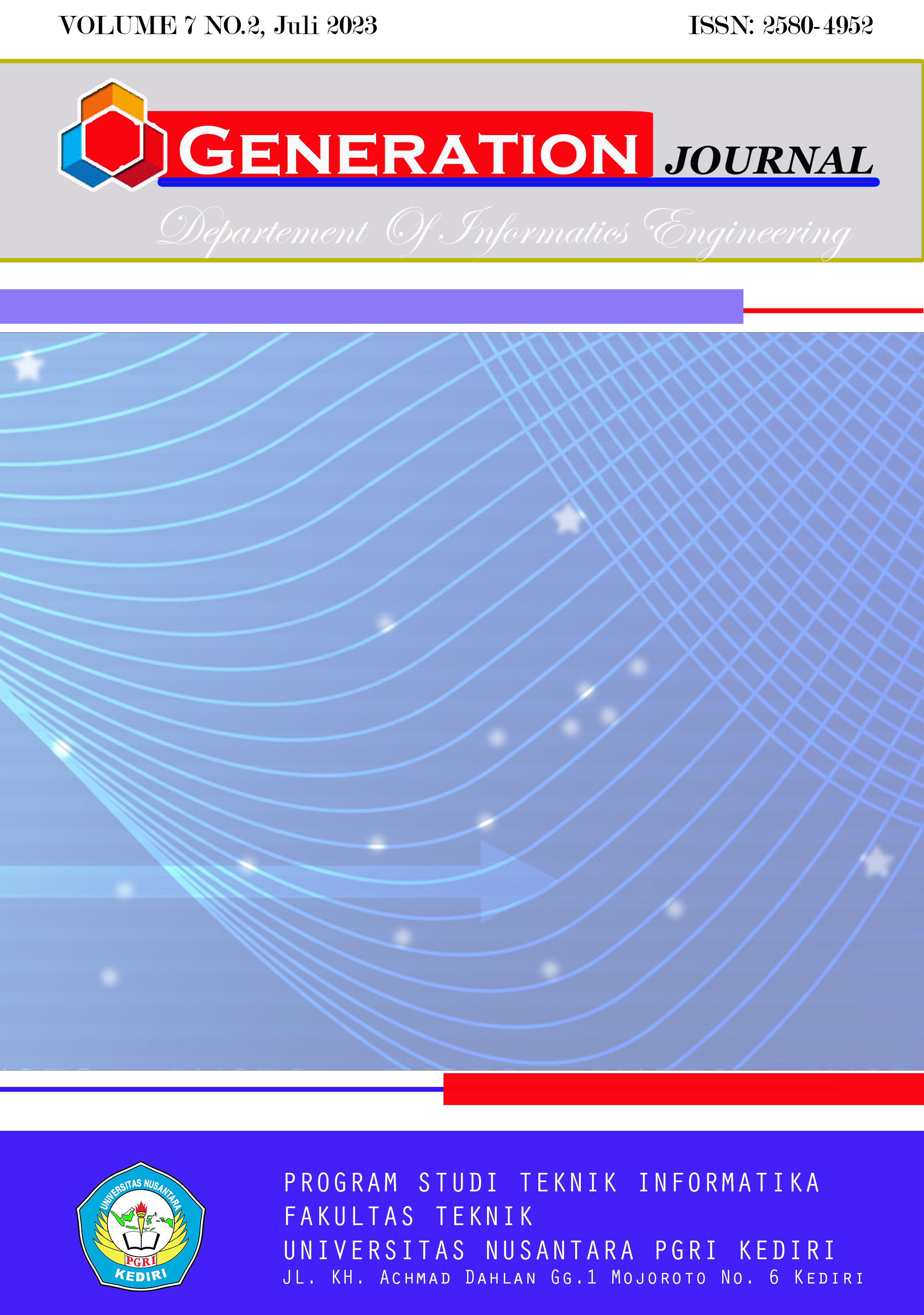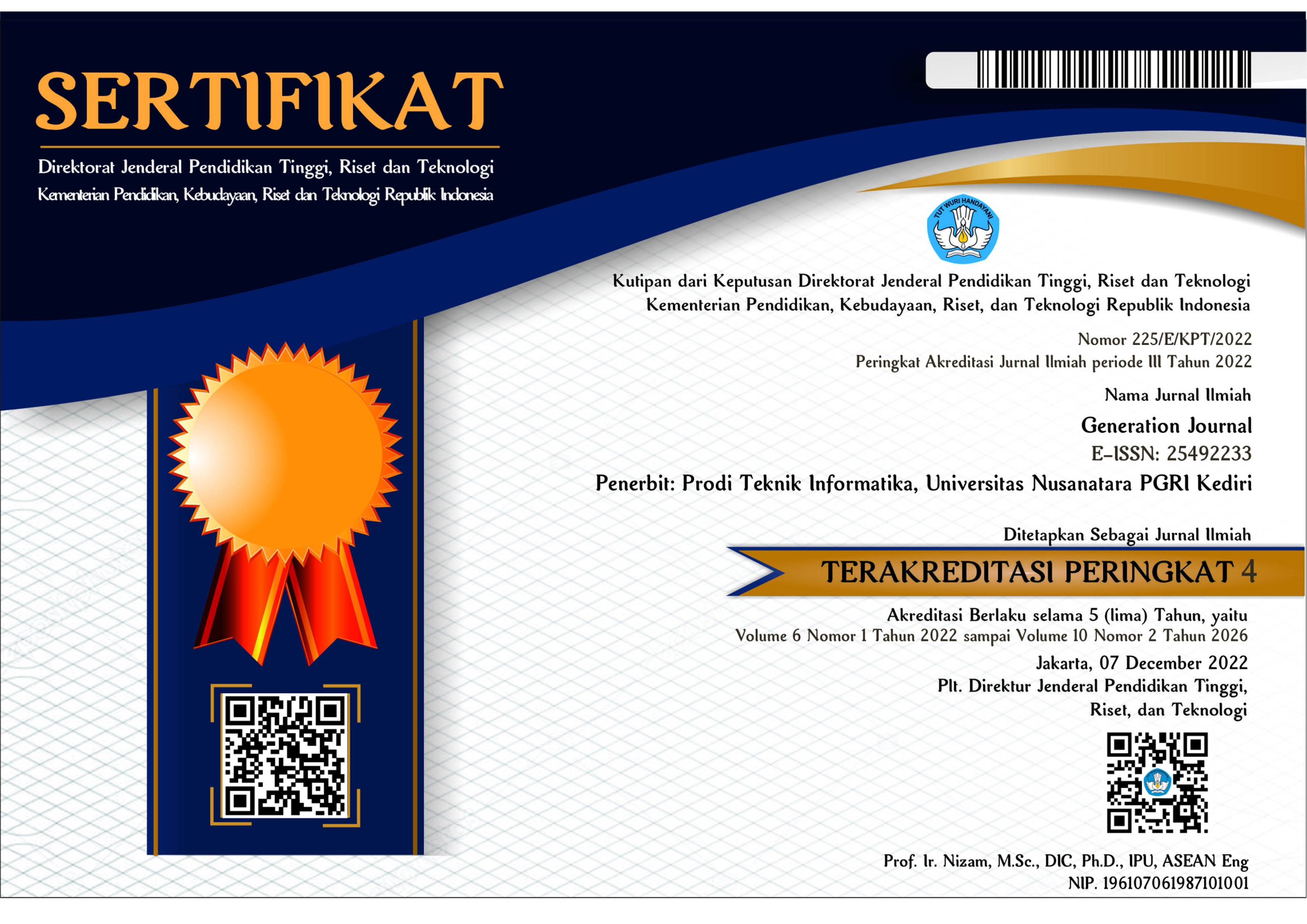Klasterisasi Hasil Belajar Matematika dengan Algoritma K-Means Clustering
DOI:
https://doi.org/10.29407/gj.v7i2.20359Keywords:
Clustering, Mathematics Learning Outcomes, K-Means Clustering AlgorithmAbstract
Mathematics has an important role in the computer field and provides a theoretical foundation for people working in the computer field. The facts show that in the Informatics Engineering study program, Unisba Blitar, the selection of specializations is carried out without considering the grades of courses that teach basic mathematical skills. In fact, mathematical ability is needed by a computer expert. For this reason, research was conducted that aimed to cluster student mathematics learning outcomes. Clustering was carried out on 51 students in semester 4, through the application of the K-means clustering algorithm. The attributes used are school origin data, majors currently in high school, and student learning outcomes in informatics logic, statistics, computational mathematics, and advanced computational mathematics courses. The results show that through clustering with the K-Means Clustering algorithm, 5 clusters are obtained, starting from the highest average score, namely cluster 2 with a value of 86.81 and the lowest average value is cluster 5 with a value of 76.50. In cluster 2, it is dominated by students from SMK graduates majoring in TKJ. Meanwhile, cluster 5 was dominated by students from high school graduates majoring in natural sciences. In addition, there are findings indicating that vocational high school graduates do not always have lower mathematical abilities than high school graduates, because intrinsic motivation also influences the level of learning outcomes.
References
A. Z. Rahmadi, N. P. Sari, S. Juliana, dan B. Rahman, “Studi Literatur : Pembelajaran Matematika Menggunakan GeoGebra dalam Meningkatkan Kemampuan Penalaran Matematis Siswa,” in Seminar Nasional Matematika Dan Pendidikan Matematika UNY, 2015, hal. 49–56.
D. Baldwin, H. M. Walker, dan P. B. Henderson, “The Roles of Mathematics in Computer Science,” ACM Inroads, vol. 4, no. 4, hal. 74–80, 2013, doi: 10.1145/2537753.2537777.
N. Puspitasari, “Kontribusi Matematika Terhadap Ilmu Komputer di D3 Manajemen Informatika Politeknik Indonusa Surakarta,” J. Inf. Politek. Indones. Surakarta, vol. 3, no. 2, hal. 18–25, 2016, [Daring]. Tersedia pada: http://www.poltekindonusa.ac.id/wp-content/uploads/2017/01/6-norma-puspitasari.pdf.
A. A. Firdaus, P. K. Nashiroh, dan Djuniadi, “Hubungan Nilai Matematika Dengan Prestasi Belajar Pemrograman Berorientasi Objek pada Siswa Kelas XII Jurusan RPL SMK Ibu Kartini Semarang,” J. Nas. Pendidik. Tek. Inform., vol. 9, no. 1, hal. 32–45, 2020, doi: 10.23887/janapati.v9i1.22680.
N. Rijati, “Peningkatan Efektifitas Pembelajaran Matematika Diskrit Dengan Metode Kooperatif Tipe STAD Berbasis TIK,” Techno. Com, vol. 7, no. 3, hal. 53–60, 2008, [Daring]. Tersedia pada: http://lppm.dinus.ac.id/dokumen/majalah/Peningkatan_Efektifitas_Pembelajaran_Matematika_Diskrit_dengan_Metode_Kooperatif_Tipe_STAD_Berbasis_TIK.pdf.
S. Suharti, S. Sulasteri, dan H. Hairunnisa, “Analisis Kemampuan Penalaran dan Kemampuan Pemecahan Masalah Matematis Mahasiswa Pendidikan Matematika Ditinjau Dari Asal Sekolah,” SJME (Supremum J. Math. Educ., vol. 5, no. 1, hal. 11–21, 2021, doi: 10.35706/sjme.v5i1.4280.
Parhaini, “Pengaruh Asal Sekolah dan Jurusan Terhadap Hasil Belajar Pengantar Dasar Matematika Mahasiswa Fakultas Tarbiyah UIN Mataram,” HIKMAH, vol. XIII, no. 2, hal. 177–198, 2017.
Aminullah dan Kusmianti, “Perbedaan Hasil Belajar Mahasiswa pada Matakuliah Matematika Antara Lulusan Sekolah Jurusan IPA dan Jurusan IPS,” J. Ganec Swara, vol. 16, no. 1, hal. 1343–1347, 2022, doi: 10.35327/gara.v16i1.271.
E. U. Oti, M. O. Olusola, F. C. Eze, dan S. U. Enogwe, “Comprehensive Review of K-Means Clustering Algorithms,” Int. J. Adv. Sci. Res. Eng., vol. 7, no. 8, hal. 64–69, 2021, doi: 10.31695/ijasre.2021.34050.
J. A. Hartigan, “Direct Clustering of Data Matrix,” J. Am. Stat. Assoc., vol. 67, no. 337, hal. 122–129, 1972.
V. E. Castro, “Why So Many Clustering Algoritms - A Position Paper,” SIGKDD Explor., vol. 4, no. 1, hal. 65–75, 2002, [Daring]. Tersedia pada: http://scholar.google.com/scholar?hl=en&btnG=Search&q=intitle:Why+so+many+clustering+algorithms#1.
S. Anwar, T. Suprapti, G. Dwilestari, dan I. Ali, “Pengelompokan Hasil Belajar Siswa dengan Metode Clustering K-Means,” JURSISTEKNI (Jurnal Sist. Inf. dan Teknol. Informasi), vol. 4, no. 2, hal. 60–72, 2022.
I. Suputra, I. Candiasa, dan I. Suryawan, “Klasterisasi Hasil Ujian Nasional SMA/MA dengan Algoritma K-Means,” Wahana Mat. dan Sains J. Mat. Sains, dan Pembelajarannya, vol. 15, no. 1, hal. 22–30, 2021, [Daring]. Tersedia pada: https://ejournal.undiksha.ac.id/index.php/JPM/article/view/25380.
F. Harahap, “Perbandingan Algoritma K Means dan K Medoids Untuk Clustering Kelas Siswa Tunagrahita,” TIN Terap. Inform. Nusant., vol. 2, no. 4, hal. 191–197, 2021.
A. Sulistiyawati dan E. Supriyanto, “Implementasi Algoritma K-means Clustring dalam Penetuan Siswa Kelas Unggulan,” J. Tekno Kompak, vol. 15, no. 2, hal. 25–36, 2021, doi: 10.33365/jtk.v15i2.1162.
S. S. P. Luka, I. M. Candiasa, dan K. Y. E. Aryanto, “Analisis Pembentukan Kelompok Diskusi Panel Siswa Menggunakan Algoritma Fuzzy C-Means Dan K-Means,” J. Pendidik. Teknol. dan Kejuru., vol. 16, no. 2, hal. 267–277, 2019, [Daring]. Tersedia pada: https://ejournal.undiksha.ac.id/index.php/JPTK/article/download/18913/11418.
Sugiyono, Metode Penelitian Kuantitatif Kualitatif dan R&D. Bandung : Alfabeta, 2013.
J. A. Hartigan dan M. A. Wong, “A K-Means Clustering Algorithm,” J. R. Stat. Soc. Ser. C (Applied Stat., vol. 28, no. 1, hal. 100–108, 1979.
T. M. Kodinariya dan P. R. Makwana, “Review on Determining of Cluster in K-means,” Int. J. Adv. Res. Comput. Sci. Manag. Stud., vol. 1, no. 6, hal. 90–95, 2013, [Daring]. Tersedia pada: https://www.researchgate.net/publication/313554124.
Sugiyanto, M. Badaruddin, Herpratiwi, S. Untung, dan Sabarudin, “The Influence of Learning Motivation on the Learning Outcomes of Vocational Students at Lampung University,” Int. J. Adv. Sci. Technol., vol. 29, no. 5, hal. 133–140, 2020.
H. Habibullah, Y. Durahim, T. Pamungkas, M. L. I. Haryundari, dan R. Rusnila, “The Effect of Motivation on Students’s Mathematics Learning Outcomes in the New Normal Era,” Jambura J. Math. Educ., vol. 3, no. 2, hal. 63–69, 2022, doi: 10.34312/jmathedu.v3i2.15114.
Downloads
Published
Issue
Section
License
Authors who publish with this journal agree to the following terms:
- Copyright on any article is retained by the author(s).
- The author grants the journal, the right of first publication with the work simultaneously licensed under a Creative Commons Attribution License that allows others to share the work with an acknowledgment of the work’s authorship and initial publication in this journal.
- Authors are able to enter into separate, additional contractual arrangements for the non-exclusive distribution of the journal’s published version of the work (e.g., post it to an institutional repository or publish it in a book), with an acknowledgment of its initial publication in this journal.
- Authors are permitted and encouraged to post their work online (e.g., in institutional repositories or on their website) prior to and during the submission process, as it can lead to productive exchanges, as well as earlier and greater citation of published work.
- The article and any associated published material is distributed under the Creative Commons Attribution-ShareAlike 4.0 International License














